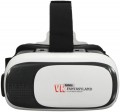The viewing angle provided by virtual reality glasses is the angular size of the space that falls into the user's field of view. Usually, the characteristics indicate the size of this space horizontally; however, if you need the most accurate information, this point needs to be specified separately.
The wider the viewing angle — the more the game space the user can see without turning his head, the more powerful the immersion effect and the less likely that the image will be subject to the "tunnel vision" effect. On the other hand, making the field of view too wide also does not make sense, given the characteristics of the human eye. In general, a
large viewing angle is considered to be an angle of 100° or more. On the other hand, there are models where this indicator is 30° or even less — these are, usually, specific devices (for example, drone piloting glasses and augmented reality glasses), where such characteristics are quite justified given the overall functionality.
The presence of a
controller — an additional control device — is included in the delivery of glasses.
The design and functionality of such an accessory may be different. So, the most popular option is specialized game controllers with a characteristic look — a handle with an analogue lever and buttons. There can be two such handles at once, under both hands; and in some models they are also used to control gestures. The movement of the hands can be tracked both by sensors in the controllers themselves and by cameras on the glasses. There are also simpler solutions — for example, portable gamepads or remote controls for controlling video playback.

